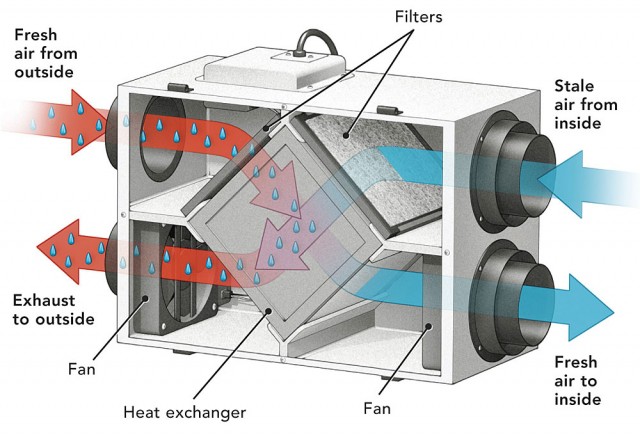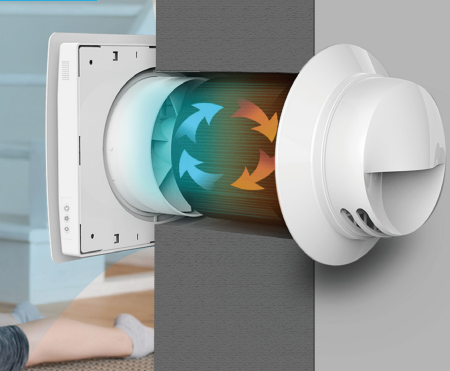Best Strategies to Care For Your HRV System
Wiki Article
Discovering the Advantages of Heat Recovery Ventilation for Energy Efficiency in Homes
Heat Recovery Ventilation (HRV) systems offer house owners a useful method to enhancing energy performance. By recovering warm from outbound air, these systems can significantly decrease heating & cooling expenses. Additionally, they give a constant supply of fresh air, boosting indoor air high quality and convenience levels. As house owners consider sustainable choices, understanding the nuances of HRV systems comes to be significantly vital. What aspects should one examine prior to making such an investment?Recognizing Heat Recovery Ventilation Equipments

Exactly How HRV Enhances Indoor Air High Quality

Power Financial Savings: The Economic Advantages of HRV
Making the most of power effectiveness, heat recovery ventilation (HRV) systems supply substantial monetary benefits for property owners. By recovering and reusing heat from exhaust air, HRVs significantly minimize cooling and heating expenses. This technology can cause power savings of as much as 30%, depending upon climate and usage patterns. Homeowners typically discover decreased utility costs shortly after setup, making HRVs an economically smart financial investment in time. In addition, many regions supply motivations or discounts for energy-efficient upgrades, even more improving the economic appeal. As power rates remain to rise, the cost-effectiveness of HRVs comes to be significantly clear. Generally, the incorporation of my review here HRV systems not just advertises power efficiency however also contributes to long-lasting monetary savings for houses.The Ecological Effect of Heat Recovery Ventilation
A considerable ecological advantage of heat recovery ventilation (HRV) systems exists in their capability to lower general energy usage. By recovering warm from exhaust air and moving it to incoming fresh air, HRV systems decrease the need for energy-intensive home heating and cooling down methods. This decrease in energy demand contributes to decrease greenhouse gas exhausts, as less fossil fuel is called for to preserve comfy interior temperatures. Additionally, HRV systems improve indoor air high quality by effectively trading stagnant air with fresh outdoor air, lowering reliance on mechanical air conditioning systems that can harm the setting. On the whole, the application of HRV systems sustains sustainable living techniques and lines up with global efforts to battle climate modification by promoting energy efficiency in property settings.
Picking the Right HRV System for Your Home
Exactly how can property owners ensure they select the ideal heat recovery ventilation (HRV) system for their needs? They must assess their home's size and format, as these elements affect airflow needs. Next off, assessing the system's performance rankings is vital, as greater rankings suggest much better performance and energy cost savings. Property owners need to likewise think about installation and upkeep expenses, comparing various brands and versions for value. Additionally, it is essential to evaluate sound degrees, as some systems run even more silently than others. Consulting with heating and cooling professionals can give customized recommendations based upon certain home conditions. Taking a look at user evaluations and service warranties can aid in making a notified choice, making certain that the selected HRV system successfully enhances interior air quality and energy performance.Frequently Asked Questions

How Commonly Should I Clean or Preserve My HRV System?
The frequency of cleansing or maintaining a warm healing air flow (HRV) system commonly depends upon use and ecological aspects. Normally, it is recommended to perform upkeep every 6 months to assure peak performance and air top quality.
Can HRV Solutions Help In Reducing Moisture Levels Inside Your Home?
HRV systems can successfully decrease interior moisture degrees by exchanging stagnant, moist air with fresh, drier air from outside. HRV Heat Recovery Ventilation. This procedure helps keep a well balanced interior setting, boosting comfort and avoiding moisture-related issues
What Is the Lifespan of a Normal HRV System?
The life-span of a regular heat sites recovery ventilation (HRV) system varies, usually lasting in between 10 to 15 years. Routine maintenance can expand its efficiency and functional life, making sure peak efficiency throughout its usage duration.Exist Any Type Of Noise Worry About HRV Systems?
Noise issues with HRV systems can develop, specifically from fan operation. Lots of modern-day devices are made to lessen sound degrees, guaranteeing they operate quietly while preserving performance, which attends to potential disruptions in living environments.Can I Set Up an HRV System Myself, or Do I Required a Specialist?
The individual contemplated whether to install the heat recovery ventilation (HRV) system click to find out more directly or hire an expert. Generally, while do it yourself setup is feasible, competence assurances appropriate performance and compliance with regional building codes, improving system effectiveness.Report this wiki page